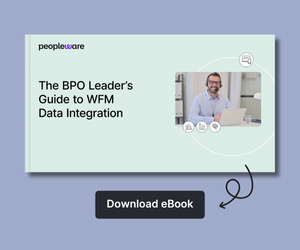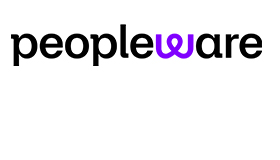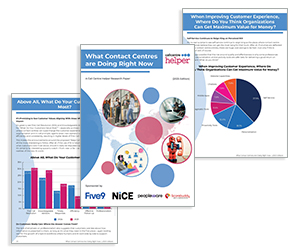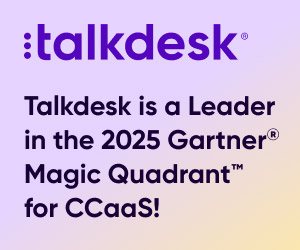Chris Dealy at Peopleware discusses how businesses can navigate the impact of increased National Insurance contributions by exploring practical solutions.
On 6th April 2025, UK Employers’ National Insurance contributions (NICs) increased from 13.8% to 15% of employee earnings. And the threshold above which employers start paying NICs fell from £9,100 to £5,000 per year.
The Employment Allowance, which allows some organisations to claim back part of their NICs, has increased to £10,500 per year.
Even so, the NIC increase is a burden for most organisations. And it has a particular impact on labour-intensive businesses in sectors like hospitality, retail – and contact centres.
Indeed estimates that the average UK call centre agent salary is approximately £23,000. That means that the annual cost of employing an average agent is now nearly £300 more than it was before April 2025.
That may not sound much, but a staffing budget that previously covered 100 agents now only pays for 99. In the high pressure call centre environment, a single agent can make all the difference between hitting or missing your performance goals and delivering a great customer experience or a terrible one.
Employer NICs are based on employee salaries. To state the obvious, there are two basic ways to reduce your total National Insurance bill: Reduce pay or reduce headcount.
On the surface, neither of those sounds practical, but there are solutions. Workforce Management (WFM) has tremendous potential to optimise staffing and therefore reduce NICs and we explore this below. But there are multiple options at your disposal and WFM is just one of them. Let’s examine them in turn.
Reduce Pay
Simply reducing pay without giving employees something in return is a recipe for industrial unrest, as the citizens of Birmingham learned during the refuse collection strike of spring 2025. But there are ways to make reducing pay a win–win for employers and employees.
Salary sacrifice is a scheme in which employees accept a reduction in pay in exchange for non-cash benefits. That reduces employer and employee NICs and reduces employee income tax.
Popular salary sacrifice benefits include pension contributions, workplace nursery schemes / childcare vouchers and cycle-to-work schemes, otherwise known as the ‘company bike’.
Other salary sacrifice benefits are possible, but the advantage of those mentioned here is that none of them are classed as ‘benefits in kind’ by HMRC. That means that employees are not liable to pay income tax on them.
Reduce Headcount
Reducing headcount will certainly reduce staffing cost and consequently reduce the NI bill. But unless you take compensating measures, there is certain to be an impact on the customer experience – and the experience of the remaining employees.
Service level will suffer. Agent stress levels will increase. You run the risk of increasing customer churn and increasing staff turnover. There are, however, several ways to reduce headcount without negative consequences.
Automation
The use of chatbots and AI has exploded in call centres over recent years and the increase in NICs provides an additional incentive to invest in the technology.
Chatbots and ‘voicebots’ can handle basic queries and escalate to a human agent when needed. Virtual agents go a step further, using conversational AI to mimic human dialogue.
Robotic Process Automation reduces the need for human effort in the back office by automating repetitive, mechanical tasks like data entry and updating CRM records. The reduction in effort translates into a reduced headcount requirement, which in turn reduces the NIC burden.
Outsourcing
The most common reason for working with a business process outsourcer (BPO) is headcount reduction. By outsourcing even a part of your call centre operation, you will reduce your headcount and thus your National Insurance bill.
The outsourcing business model relies on the fact that a BPO can often offer a more cost-effective solution than internal operations due to lean administrative structures and lower operating costs.
Outsourcing also makes it easier to staff around peaks and troughs in your workload. We explore contact centre outsourcing in this blog post. Needless to say, not all BPOs are the same and you should select an outsourcing partner carefully.
You need a partner with the right industry experience, compatible technology and a culture that’s aligned with your brand and values.
Gig Workers
Unlike permanent employees, contractors or ‘gig workers’ are not subject to National Insurance contributions. Replacing a subset of your employees with gig workers will therefore reduce your NI bill. The cost savings don’t end there.
There is little shrinkage overhead because gig workers don’t have paid holidays, parental leave or sick pay. And if they’re working short shifts, they don’t have breaks. Plus, you don’t have to make pension contributions.
There are downsides to using gig workers. Effort on selecting, vetting and training gig workers is likely to be higher than for permanent employees.
Gig worker turnover may be higher. A different style of management may be needed. And there is a risk that gig workers won’t be available when you need them most.
Planning with gig workers can increase your schedule efficiency. Practically every contact centre experiences peaks and troughs in workload by time of day, day of week and with the seasons.
This variable workload can be difficult to cover with permanent employees without creating periods of wasteful over-staffing. Gig customer service agents can be brought in for short shifts to cover the peaks and thus more efficiently match supply and demand.
Workforce Management
In every contact centre, three opposing forces are in play:
- Customer satisfaction, e.g. hitting service level goals
- Agent experience, e.g. not burning agents out because staffing levels are too low
- Business efficiency, e.g. minimising the cost of running the business – including National Insurance costs
Faced with an increased NI bill, there’s a temptation to reduce headcount in the name of business efficiency. Doing this without taking care of the customer experience or the agent experience will not end well.
This is where workforce management (WFM) comes into its own. WFM is about optimising the balance between the three forces, delivering improved outcomes for customers and employees, while minimising costs.
Many contact centres have already adopted WFM. Agents love having self-service options for booking time off, swapping shifts and viewing their schedules.
And WFM massively streamlines the planning process, freeing up planners from tedious number-crunching. Once WFM is ‘part of the furniture’, it’s easy to forget its main purpose: To optimise the deployment of the most valuable – and expensive – resource in every contact centre: the employees.
That means building schedules that are optimised around customer demand. Optimised schedules avoid periods of understaffing, which lead to a poor customer experience and agent burnout.
Critically, optimised schedules avoid periods of overstaffing. It is by reducing overstaffing that WFM enables headcount reduction.
WFM also enables more accurate forecasting, so you won’t end up overstaffing to cover demand that never materialised.
And WFM enables improvements to agent schedule adherence, so you don’t just schedule people to be in the right places at the right times – they’re actually logged in when you need them.
It’s important to remember that WFM is not about laying people off. Rather, it simply enables headcount to be reduced over time by not replacing all the employees who leave through natural staff turnover.
Reducing headcount without negative consequences is where WFM delivers most of its return-on-investment (ROI). The increase in NICs means that the payback of WFM has never been stronger.
Not all WFM systems are created equal. You need WFM software that’s capable of delivering highly efficient, optimised schedules that consistently align the supply of agents with customer demand.
The schedules need to take employee preferences into account and of course, respect all relevant constraints such as labour laws. You need modern forecasting that consistently delivers accurate forecasts for all channels.
And there should not be huge setup and maintenance effort, even in a complex multi-skill, omnichannel environment. If you already have a WFM system and it doesn’t sound like that, you should challenge your vendor – or look for alternatives.
If you don’t already have a WFM system, these capabilities should definitely be on your list of vendor selection ‘must-haves’.
The payroll system will take care of the increased NICs, but it is in Workforce Management where the battle for efficiency happens.
With a smart WFM platform, you can offset rising costs with more efficient scheduling, tighter adherence, and more accurate forecasting.
Key Takeaways
- The increase in Employers’ National Insurance Contributions (NICs) in April 2025 means that a staffing budget that previously paid for 100 agents now only pays for 99.
- There are two ways to reduce the NI bill: reduce pay or reduce headcount.
- You can reduce pay without negatively impacting employee remuneration by offering benefits such as pension contributions and childcare vouchers via salary sacrifice.
- You can reduce headcount by implementing automation, outsourcing, gig workers or workforce management.
- Workforce management is well known for streamlining the planning process.
- The core purpose of WFM is to optimise headcount and thus the NI bill, without damaging customer satisfaction or the employee experience.
This blog post has been re-published by kind permission of Peopleware – View the Original Article
For more information about Peopleware - visit the Peopleware Website
Call Centre Helper is not responsible for the content of these guest blog posts. The opinions expressed in this article are those of the author, and do not necessarily reflect those of Call Centre Helper.
Author: Peopleware
Reviewed by: Rachael Trickey
Published On: 19th May 2025 - Last modified: 21st May 2025
Read more about - Guest Blogs, Chris Dealy, Peopleware






 Peopleware is a leading workforce management (WFM) solution, trusted by over 500,000 users in 30+ countries. With smart forecasting, automated scheduling and real-time management, organizations can optimize workforce efficiency and keep work aligned with demand. From precise time tracking to flexible planning, Peopleware helps organizations boost operational efficiency and foster a more engaged, productive workforce.
Peopleware is a leading workforce management (WFM) solution, trusted by over 500,000 users in 30+ countries. With smart forecasting, automated scheduling and real-time management, organizations can optimize workforce efficiency and keep work aligned with demand. From precise time tracking to flexible planning, Peopleware helps organizations boost operational efficiency and foster a more engaged, productive workforce. 































